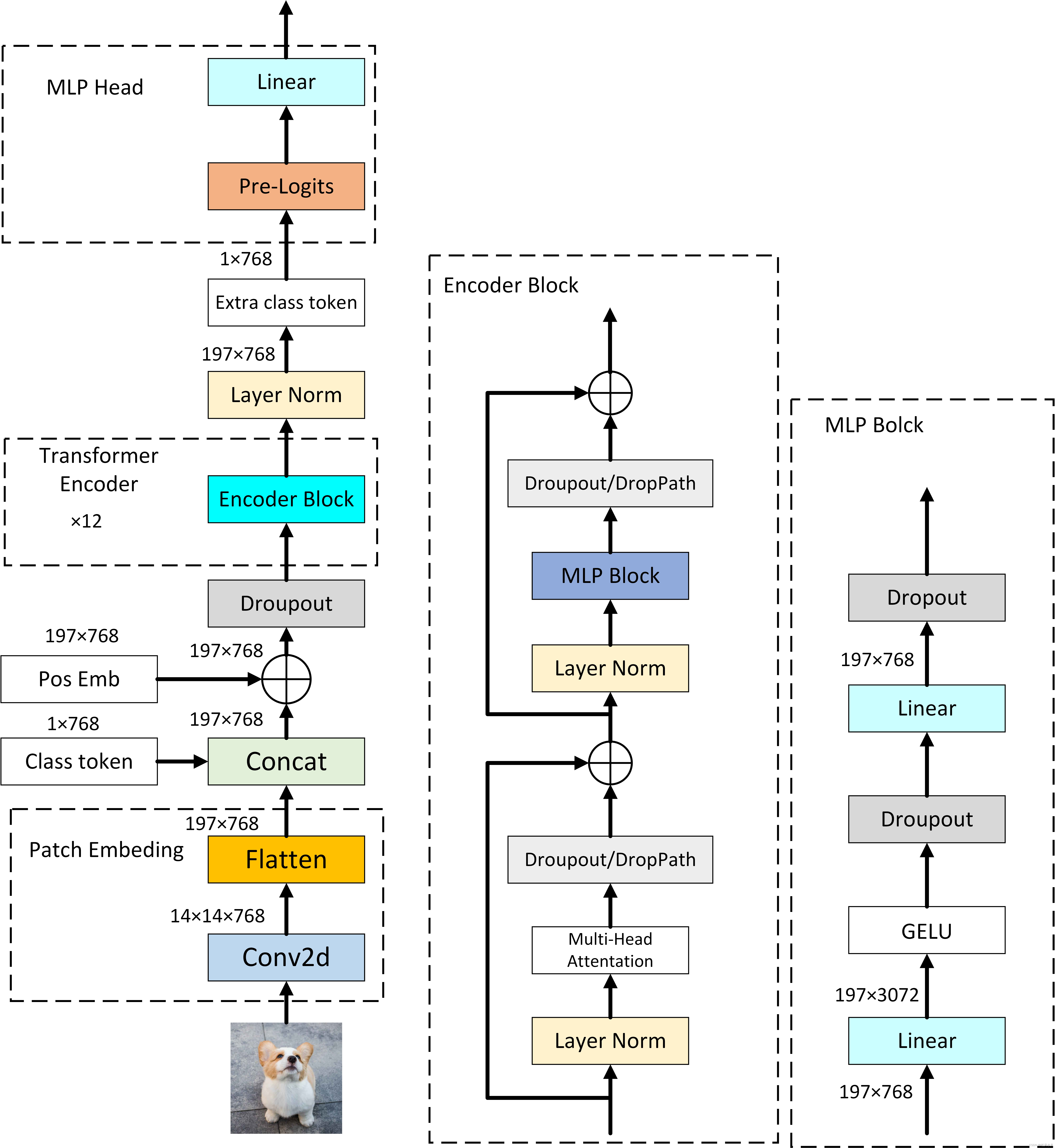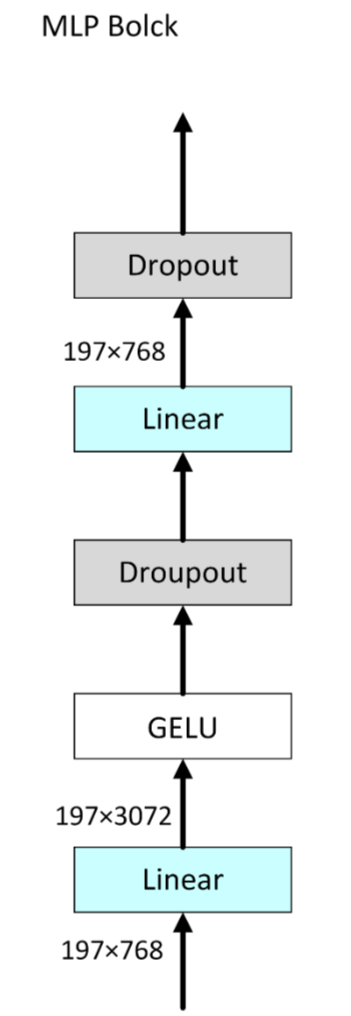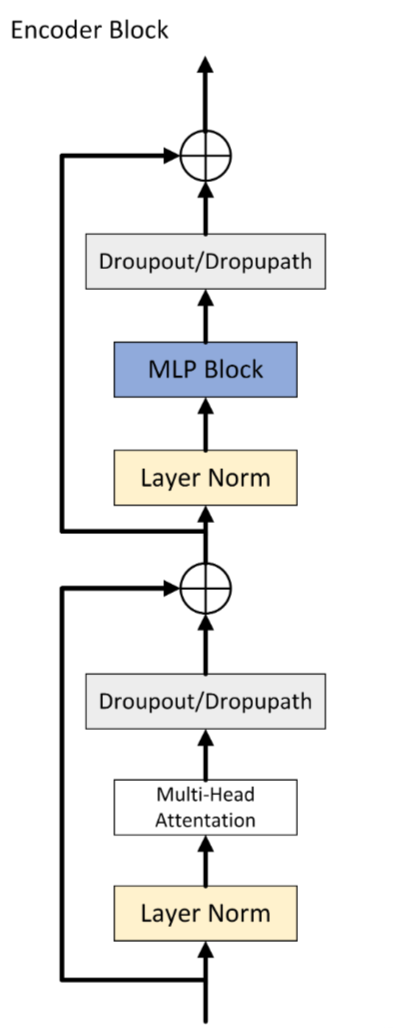
原文链接
https://blog.csdn.net/qq_38683460/article/details/127346916
代码分析
在分下代码之前,我们先看下VIT的网络结构,如下图:

从上面的框图可以看出,VIT的主要组成结构大致可以分为三部分,分别是Patch Embeding、Transformer Encoder、MLP Head三部分。我们下面分析代码也是主要从这三部分进行分析,先分析每个小模块做了什么事情,再分析整个VIT的架构。
DropPath模块
def drop_path(x, drop_prob: float = 0., training: bool = False):
"""
Drop paths (Stochastic Depth) per sample (when applied in main path of residual blocks).
This is the same as the DropConnect impl I created for EfficientNet, etc networks, however,
the original name is misleading as 'Drop Connect' is a different form of dropout in a separate paper...
See discussion: https://github.com/tensorflow/tpu/issues/494#issuecomment-532968956 ... I've opted for
changing the layer and argument names to 'drop path' rather than mix DropConnect as a layer name and use
'survival rate' as the argument.
"""
if drop_prob == 0. or not training:
return x
# 保留的分支概率
keep_prob = 1 - drop_prob
# shape (b, 1, 1, 1),其中x.ndim输出结果为x的维度,即4。目的是为了创建一个失活矩阵。
shape = (x.shape[0],) + (1,) * (x.ndim - 1) # work with diff dim tensors, not just 2D ConvNets
random_tensor = keep_prob + torch.rand(shape, dtype=x.dtype, device=x.device)
# 向下取整用于确定保存哪些样本,floor_()是floor的原位运算
random_tensor.floor_() # binarize
# 除以keep_drop让一部分分支失活,恒等映射
output = x.div(keep_prob) * random_tensor
return output
class DropPath(nn.Module):
"""
Drop paths (Stochastic Depth) per sample (when applied in main path of residual blocks).
"""
def __init__(self, drop_prob=None):
super(DropPath, self).__init__()
self.drop_prob = drop_prob
def forward(self, x):
return drop_path(x, self.drop_prob, self.training)
在Encoder Block中使用了两个DropPath,我们先来简单介绍下什么是DropPath。DropPath是随机的将深度学习中的多分支结构进行删除,而Dropout 是对神经元随机 “失效”。假设在前向传播中有如下的代码:
x = x + self.drop_path( self.conv(x) )
那么在drop_path分支中,每个batch有drop_prob的概率样本在 self.conv(x) 不会 “执行”,会以0直接传递。若x为输入的张量,其通道为[B,C,H,W],那么drop_path的含义为在一个Batch_size中,随机有drop_prob的样本,不经过主干,而直接由分支进行恒等映射。需要注意的是,不能通过下面的方法进行drop_path:
x = self.drop_path(x)
Patch Embeding
上面解释了DropPath的用法,下面我们来看下Patch Embeding的用法,先上代码。
class PatchEmbed(nn.Module):
"""
2D Image to Patch Embedding
"""
def __init__(self, img_size=224, patch_size=16, in_c=3, embed_dim=768, norm_layer=None):
super().__init__()
img_size = (img_size, img_size)
patch_size = (patch_size, patch_size)
self.img_size = img_size
self.patch_size = patch_size
# 14*14
self.grid_size = (img_size[0] // patch_size[0], img_size[1] // patch_size[1])
# 196
self.num_patches = self.grid_size[0] * self.grid_size[1]
# 不同的模型emd_dim会变化
self.proj = nn.Conv2d(in_c, embed_dim, kernel_size=patch_size, stride=patch_size)
# 传入nor_mlayer就使用传入的norm_layer,否则就使用Identity不用做任何操作
self.norm = norm_layer(embed_dim) if norm_layer else nn.Identity()
def forward(self, x):
# 获取图片的大小信息
B, C, H, W = x.shape
# 传入的图片高和宽和预设的不一样就会报错,VIT模型里面输入的图像大小必须是固定的
assert H == self.img_size[0] and W == self.img_size[1], \
f"Input image size ({H}*{W}) doesn't match model ({self.img_size[0]}*{self.img_size[1]})."
# flatten: [B, C, H, W] -> [B, C, HW]
# transpose: [B, C, HW] -> [B, HW, C]
# 进过卷积之后从第2维度开始展平,之后再交换1,2维度(为了计算方便)
x = self.proj(x).flatten(2).transpose(1, 2)
x = self.norm(x)
# print(s.shape)
return x
我们来看下这个模块的最终输出结果是什么,把上面的print(s.shape)注释给取消掉(输入的图像大小为(224,224)),看下输出结果。
torch.Size([1, 196, 768])
可以看到输入一个大小为(1,3,224,224)的矩阵后,经过Patch Embeding后变成了[1, 196, 768],也就是把我们之前输入的二位矩阵都变成了一维向量了,这个时候就可以使用Transformer来进行建模了,因为Transformer只能接受一维向量。
Multi-Head Attention
下面这个模块使我们整个VIT的核心,我们来对每句代码进行逐一分析,看看是怎么实现Transformer里面的注意力机制的。
class Attention(nn.Module):
def __init__(self,
dim, # 输入token的dim,768
num_heads=8, # 8个头,实例化的时候是12个头
qkv_bias=False,
qk_scale=None,
attn_drop_ratio=0.,
proj_drop_ratio=0.):
super(Attention, self).__init__()
self.num_heads = num_heads
# 计算每个head的dim,直接均分操作。
head_dim = dim // num_heads
# 计算分母,q,k相乘之后要除以一个根号下dk。
self.scale = qk_scale or head_dim ** -0.5
# 直接使用一个全连接实现q,k,v。
self.qkv = nn.Linear(dim, dim * 3, bias=qkv_bias)
self.attn_drop = nn.Dropout(attn_drop_ratio)
# 多头拼接之后通过W进行映射,跟上面的q,k,v一样,也是通过全连接实现。
self.proj = nn.Linear(dim, dim)
self.proj_drop = nn.Dropout(proj_drop_ratio)
def forward(self, x):
# [batch_size, num_patches + 1, total_embed_dim],即(B,197,768)
B, N, C = x.shape
# qkv(): -> [batch_size, num_patches + 1, 3 * total_embed_dim]
# reshape: -> [batch_size, num_patches + 1, 3, num_heads, embed_dim_per_head],即(B,197,3,12,64)
# permute: -> [3, batch_size, num_heads, num_patches + 1, embed_dim_per_head],即(3,B,12,197,64)
# C // self.num_heads:每个head的q,k,v对应的维度
# Linear函数可以接收多维的矩阵输入但是只对最后一维起效果,其他维度不变。permute()函数用于调整维度。
qkv = self.qkv(x).reshape(B, N, 3, self.num_heads, C // self.num_heads).permute(2, 0, 3, 1, 4)
# [batch_size, num_heads, num_patches + 1, embed_dim_per_head]
# 通过切片获取q,k,v
q, k, v = qkv[0], qkv[1], qkv[2] # make torchscript happy (cannot use tensor as tuple)
# transpose: -> [batch_size, num_heads, embed_dim_per_head, num_patches + 1]
# @: multiply -> [batch_size, num_heads, num_patches + 1, num_patches + 1]。@为矩阵乘法,q,k是多维矩阵,只有最后两个维度进行矩阵乘法。
# 每个head的q,k进行相乘。输出维度大小为(1,12,197,197)
attn = (q @ k.transpose(-2, -1)) * self.scale
# 在最后一个维度,即每一行进行softmax处理
attn = attn.softmax(dim=-1)
# softmax处理后要经过一个dropout层
attn = self.attn_drop(attn)
# @: multiply -> [batch_size, num_heads, num_patches + 1, embed_dim_per_head]
# transpose: -> [batch_size, num_patches + 1, num_heads, embed_dim_per_head]
# reshape: -> [batch_size, num_patches + 1, total_embed_dim]
# q,k矩阵相乘的结果要和v相乘得到一个加权结果,输出维度为(1,12,197,64),然后交换1,2维度,再进行reshape操作,其实这个reshape操作就是对多头的拼接,得到最后的输出shape为(1,197,768)
x = (attn @ v).transpose(1, 2).reshape(B, N, C)
# 经过Woy映射,也就是一个全连接层
x = self.proj(x)
# 经过一个dropout层。一般全连接后面都跟一个dropout层
x = self.proj_drop(x)
return x
上面的代码基本上每句都给了注释,有些地方可能会让人有点费解,就是下面这句话:
qkv = self.qkv(x).reshape(B, N, 3, self.num_heads, C // self.num_heads).permute(2, 0, 3, 1, 4)
MLP
上面我们把VIT的核心代码理了一下,下面的内容就不比较简单了,就是对这些模块的拼接,在介绍这些模块的拼接之前,我们还是先把MLP这个结构先看下,如下图。

class Mlp(nn.Module):
"""
MLP as used in Vision Transformer, MLP-Mixer and related networks
"""
def __init__(self, in_features, hidden_features=None, out_features=None, act_layer=nn.GELU, drop=0.):
super().__init__()
out_features = out_features or in_features
hidden_features = hidden_features or in_features
self.fc1 = nn.Linear(in_features, hidden_features)
self.act = act_layer()
self.fc2 = nn.Linear(hidden_features, out_features)
self.drop = nn.Dropout(drop)
def forward(self, x):
x = self.fc1(x)
x = self.act(x)
x = self.drop(x)
x = self.fc2(x)
x = self.drop(x)
return x
MLP的结构比较简答,代码也比较好理解,其中有一点需要注意,就是第一个全连接之后把输出维度剩了4倍,第二个全连接又将其还原回去。
Block
上面简单看了下MLP的代码,比较简单,就不过多介绍了,下面我们再来看下Block这个模块,我们的Transformer Encoder就是对其进行堆叠12次得到的,我们再来看下Encoder Block模块,如下图:

下面我们来分析下代码:
class Block(nn.Module):
def __init__(self,
dim,
num_heads, # 第一个全连接的倍率
mlp_ratio=4.,
qkv_bias=False,
qk_scale=None,
drop_ratio=0., # 对应multi-head attention最后全连接层的失活比例
attn_drop_ratio=0.,# q,k矩阵相乘之后通过softmax之后的全连接层的失活比例
drop_path_ratio=0., # 框图中Droppath失活比例。也可以使用dropout,没啥影响
act_layer=nn.GELU,
norm_layer=nn.LayerNorm):
super(Block, self).__init__()
# layernorm层
self.norm1 = norm_layer(dim)
# 实例化上面讲的Attention类
self.attn = Attention(dim, num_heads=num_heads, qkv_bias=qkv_bias, qk_scale=qk_scale,
attn_drop_ratio=attn_drop_ratio, proj_drop_ratio=drop_ratio)
# NOTE: drop path for stochastic depth, we shall see if this is better than dropout here
# 失活比例大于0就实例化DropPath,否者不做任何操作
self.drop_path = DropPath(drop_path_ratio) if drop_path_ratio > 0. else nn.Identity()
# 第二个layernorm层
self.norm2 = norm_layer(dim)
# 第一个全连接之后输出维度翻四倍
mlp_hidden_dim = int(dim * mlp_ratio)
# 实例化mlp
self.mlp = Mlp(in_features=dim, hidden_features=mlp_hidden_dim, act_layer=act_layer, drop=drop_ratio)
def forward(self, x):
x = x + self.drop_path(self.attn(self.norm1(x)))
x = x + self.drop_path(self.mlp(self.norm2(x)))
return x
VisionTransformer
上面所有的模块我们都创建好了,下面就到了最后的拼接部分了,结合上面的模块搭建我们的VisionTransformer模块,直接看代码:
class VisionTransformer(nn.Module):
def __init__(self, img_size=224, patch_size=16, in_c=3, num_classes=1000,
embed_dim=768, depth=12, num_heads=12, mlp_ratio=4.0, qkv_bias=True,
qk_scale=None, representation_size=None, distilled=False, drop_ratio=0.,
attn_drop_ratio=0., drop_path_ratio=0., embed_layer=PatchEmbed, norm_layer=None,
act_layer=None):
"""
Args:
img_size (int, tuple): input image size
patch_size (int, tuple): patch size
in_c (int): number of input channels
num_classes (int): number of classes for classification head
embed_dim (int): embedding dimension
depth (int): depth of transformer,就是我们上面的Block堆叠多少次
num_heads (int): number of attention heads
mlp_ratio (int): ratio of mlp hidden dim to embedding dim
qkv_bias (bool): enable bias for qkv if True
qk_scale (float): override default qk scale of head_dim ** -0.5 if set
representation_size (Optional[int]): enable and set representation layer (pre-logits) to this value if set。对应的是最后的MLP中的pre-logits中的全连接层的节点个数。默认是none,也就是不会去构建MLP中的pre-logits,mlp中只有一个全连接层。
distilled (bool): model includes a distillation token and head as in DeiT models。为了兼容Deit模型,不用管。
drop_ratio (float): dropout rate
attn_drop_ratio (float): attention dropout rate
drop_path_ratio (float): stochastic depth rate
embed_layer (nn.Module): patch embedding layer
norm_layer: (nn.Module): normalization layer
"""
super(VisionTransformer, self).__init__()
self.num_classes = num_classes
self.num_features = self.embed_dim = embed_dim # num_features for consistency with other models
# 不用管distilled,所有self.num_tokens=1
self.num_tokens = 2 if distilled else 1
#norm_layer默认为none,所有norm_layer=nn.LayerNorm,用partial方法给一个默认参数。partial 函数的功能就是:把一个函数的某些参数给固定住,返回一个新的函数。
norm_layer = norm_layer or partial(nn.LayerNorm, eps=1e-6)
# act_layer默认等于GELU函数
act_layer = act_layer or nn.GELU
# 通过embed_layer构建PatchEmbed
self.patch_embed = embed_layer(img_size=img_size, patch_size=patch_size, in_c=in_c, embed_dim=embed_dim)
# 获得num_patches的总个数196
num_patches = self.patch_embed.num_patches
# 创建一个cls_token,形状为(1,768),直接通过0矩阵进行初始化,后面在训练学习。下面要和num_patches进行拼接,加上一个类别向量,从而变成(197,768)
self.cls_token = nn.Parameter(torch.zeros(1, 1, embed_dim))
# 不用管,用不到,因为distilled默认为none
self.dist_token = nn.Parameter(torch.zeros(1, 1, embed_dim)) if distilled else None
# 创建一个位置编码,形状为(197,768)
self.pos_embed = nn.Parameter(torch.zeros(1, num_patches + self.num_tokens, embed_dim))
# 此处的dropout为加上位置编码后的dropout层
self.pos_drop = nn.Dropout(p=drop_ratio)
# 根据传入的drop_path_ratio构建一个等差序列,总共depth个元素,即在每个Encoder Block中的失活比例都不一样。默认为0,可以传入参数改变。
dpr = [x.item() for x in torch.linspace(0, drop_path_ratio, depth)] # stochastic depth decay rule
# 构建blocks,首先通过列表创建depth次,也就是12次。然后通过nn.Sequential方法把列表中的所有元素打包成整体赋值给self.blocks。
self.blocks = nn.Sequential(*[
Block(dim=embed_dim, num_heads=num_heads, mlp_ratio=mlp_ratio, qkv_bias=qkv_bias, qk_scale=qk_scale,
drop_ratio=drop_ratio, attn_drop_ratio=attn_drop_ratio, drop_path_ratio=dpr[i],
norm_layer=norm_layer, act_layer=act_layer)
for i in range(depth)
])
# 通过norm_layer层
self.norm = norm_layer(embed_dim)
# distilled不用管,只用看representation_size即可,如果有传入representation_size,在MLP中就会构建pre-logits。否者直接 self.has_logits = False,然后执行self.pre_logits = nn.Identity(),相当于没有pre-logits。
if representation_size and not distilled:
self.has_logits = True
self.num_features = representation_size
self.pre_logits = nn.Sequential(OrderedDict([
("fc", nn.Linear(embed_dim, representation_size)),
("act", nn.Tanh())
]))
else:
self.has_logits = False
self.pre_logits = nn.Identity()
# 整个网络的最后一层全连接层,输出就是分类类别个数,前提要num_classes > 0
self.head = nn.Linear(self.num_features, num_classes) if num_classes > 0 else nn.Identity()
self.head_dist = None
if distilled:
self.head_dist = nn.Linear(self.embed_dim, self.num_classes) if num_classes > 0 else nn.Identity()
# 权重初始化
nn.init.trunc_normal_(self.pos_embed, std=0.02)
if self.dist_token is not None:
nn.init.trunc_normal_(self.dist_token, std=0.02)
nn.init.trunc_normal_(self.cls_token, std=0.02)
self.apply(_init_vit_weights)
def forward_features(self, x):
# [B, C, H, W] -> [B, num_patches, embed_dim]
# 先进性patch_embeding处理
x = self.patch_embed(x) # [B, 196, 768]
# [1, 1, 768] -> [B, 1, 768]
# 对cls_token在batch维度进行复制batch_size份
cls_token = self.cls_token.expand(x.shape[0], -1, -1)
# self.dist_token默认为none。
if self.dist_token is None:
# 在dim=1的维度上进行拼接,输出shape:[B, 197, 768]
x = torch.cat((cls_token, x), dim=1) # [B, 197, 768]
else:
x = torch.cat((cls_token, self.dist_token.expand(x.shape[0], -1, -1), x), dim=1)
# 位置编码后有个dropout层
x = self.pos_drop(x + self.pos_embed)
# 通过我们刚才构建好的blocks层。
x = self.blocks(x)
# 再通过一个normlayer层
x = self.norm(x)
# 提取clc_token对应的输出,也就是提取出类别向量。
if self.dist_token is None:
# 返回所有的batch维度和第二个维度上面索引为0的数据
return self.pre_logits(x[:, 0])
else:
return x[:, 0], x[:, 1]
def forward(self, x):
# 首先将x传给forward_features()函数,输出shape为(1,768)
x = self.forward_features(x)
# self.head_dist默认为none,自动执行else后面的语句
if self.head_dist is not None:
x, x_dist = self.head(x[0]), self.head_dist(x[1])
if self.training and not torch.jit.is_scripting():
# during inference, return the average of both classifier predictions
return x, x_dist
else:
return (x + x_dist) / 2
else:
# 输出特征大小为(1,1000),对应1000分类
x = self.head(x)
return x
构建VIT模型
上面我们把VIT所有的代码都分析清除了,并且搭建了VisionTransformer,你以为到这就结束了吗?还没有,下面我们对VisionTransformer再进行封装以方便我们直接调用。按惯例,直接上代码:
def vit_base_patch16_224_in21k(num_classes: int = 21843, has_logits: bool = True):
# num_classes表示分类类别个数,因为原始代码是在ImageNet21k上预训练的,所以这里为21843.
# has_logits:是否有这个模块,预训练的时候是有的,不加也可以,这样就只剩全连接层了
"""
ViT-Base model (ViT-B/16) from original paper (https://arxiv.org/abs/2010.11929).
ImageNet-21k weights @ 224x224, source https://github.com/google-research/vision_transformer.
weights ported from official Google JAX impl:
https://github.com/rwightman/pytorch-image-models/releases/download/v0.1-vitjx/jx_vit_base_patch16_224_in21k-e5005f0a.pth
"""
# 创建模型
# img_size:图像尺寸
# patch_size:图像切块大小
# 图像切块后每个小块的向量维度大小,即送入multi-head attention模块的向量长度
# depth:block模块的堆叠次数
# num_heads:采用几头注意力
# representation_size:pre-logits里面用的
# num_classes:分类类别数
model = VisionTransformer(img_size=224,
patch_size=16,
embed_dim=768,
depth=12,
num_heads=12,
representation_size=768 if has_logits else None,
num_classes=num_classes)
return model
def vit_base_patch32_224_in21k(num_classes: int = 21843, has_logits: bool = True):
"""
ViT-Base model (ViT-B/32) from original paper (https://arxiv.org/abs/2010.11929).
ImageNet-21k weights @ 224x224, source https://github.com/google-research/vision_transformer.
weights ported from official Google JAX impl:
https://github.com/rwightman/pytorch-image-models/releases/download/v0.1-vitjx/jx_vit_base_patch32_224_in21k-8db57226.pth
"""
model = VisionTransformer(img_size=224,
patch_size=32,
embed_dim=768,
depth=12,
num_heads=12,
representation_size=768 if has_logits else None,
num_classes=num_classes)
return model
def vit_large_patch16_224_in21k(num_classes: int = 21843, has_logits: bool = True):
"""
ViT-Large model (ViT-L/16) from original paper (https://arxiv.org/abs/2010.11929).
ImageNet-21k weights @ 224x224, source https://github.com/google-research/vision_transformer.
weights ported from official Google JAX impl:
https://github.com/rwightman/pytorch-image-models/releases/download/v0.1-vitjx/jx_vit_large_patch16_224_in21k-606da67d.pth
"""
model = VisionTransformer(img_size=224,
patch_size=16,
embed_dim=1024,
depth=24,
num_heads=16,
representation_size=1024 if has_logits else None,
num_classes=num_classes)
return model
def vit_large_patch32_224_in21k(num_classes: int = 21843, has_logits: bool = True):
"""
ViT-Large model (ViT-L/32) from original paper (https://arxiv.org/abs/2010.11929).
ImageNet-21k weights @ 224x224, source https://github.com/google-research/vision_transformer.
weights ported from official Google JAX impl:
https://github.com/rwightman/pytorch-image-models/releases/download/v0.1-vitjx/jx_vit_large_patch32_224_in21k-9046d2e7.pth
"""
model = VisionTransformer(img_size=224,
patch_size=32,
embed_dim=1024,
depth=24,
num_heads=16,
representation_size=1024 if has_logits else None,
num_classes=num_classes)
return model
def vit_huge_patch14_224_in21k(num_classes: int = 21843, has_logits: bool = True):
"""
ViT-Huge model (ViT-H/14) from original paper (https://arxiv.org/abs/2010.11929).
ImageNet-21k weights @ 224x224, source https://github.com/google-research/vision_transformer.
NOTE: converted weights not currently available, too large for github release hosting.
"""
model = VisionTransformer(img_size=224,
patch_size=14,
embed_dim=1280,
depth=32,
num_heads=16,
representation_size=1280 if has_logits else None,
num_classes=num_classes)
return model
# 模型测试
if __name__ == "__main__":
model = vit_base_patch16_224_in21k(num_classes=1000, has_logits=False)
data = torch.rand(1, 3, 224, 224)
out = model(data)
# print(out.shape)
从上面的代码可以看到,总共5个模型,从上到下复杂的依次递增,上面介绍了一vit_base_patch16_224_in21k这个模型的创建配置参数,其他模型的参数大同小异。
完整代码
"""
original code from rwightman:
https://github.com/rwightman/pytorch-image-models/blob/master/timm/models/vision_transformer.py
"""
from functools import partial
from collections import OrderedDict
import torch
import torch.nn as nn
def drop_path(x, drop_prob: float = 0., training: bool = False):
"""
Drop paths (Stochastic Depth) per sample (when applied in main path of residual blocks).
This is the same as the DropConnect impl I created for EfficientNet, etc networks, however,
the original name is misleading as 'Drop Connect' is a different form of dropout in a separate paper...
See discussion: https://github.com/tensorflow/tpu/issues/494#issuecomment-532968956 ... I've opted for
changing the layer and argument names to 'drop path' rather than mix DropConnect as a layer name and use
'survival rate' as the argument.
"""
if drop_prob == 0. or not training:
return x
keep_prob = 1 - drop_prob
shape = (x.shape[0],) + (1,) * (x.ndim - 1) # work with diff dim tensors, not just 2D ConvNets
random_tensor = keep_prob + torch.rand(shape, dtype=x.dtype, device=x.device)
random_tensor.floor_() # binarize
output = x.div(keep_prob) * random_tensor
return output
class DropPath(nn.Module):
"""
Drop paths (Stochastic Depth) per sample (when applied in main path of residual blocks).
"""
def __init__(self, drop_prob=None):
super(DropPath, self).__init__()
self.drop_prob = drop_prob
def forward(self, x):
return drop_path(x, self.drop_prob, self.training)
class PatchEmbed(nn.Module):
"""
2D Image to Patch Embedding
"""
def __init__(self, img_size=224, patch_size=16, in_c=3, embed_dim=768, norm_layer=None):
super().__init__()
# (224,224)
img_size = (img_size, img_size)
# (16,16)
patch_size = (patch_size, patch_size)
self.img_size = img_size
self.patch_size = patch_size
# (14,14)
self.grid_size = (img_size[0] // patch_size[0], img_size[1] // patch_size[1])
# 196
self.num_patches = self.grid_size[0] * self.grid_size[1]
self.proj = nn.Conv2d(in_c, embed_dim, kernel_size=patch_size, stride=patch_size)
self.norm = norm_layer(embed_dim) if norm_layer else nn.Identity()
def forward(self, x):
B, C, H, W = x.shape
assert H == self.img_size[0] and W == self.img_size[1], \
f"Input image size ({H}*{W}) doesn't match model ({self.img_size[0]}*{self.img_size[1]})."
# flatten: [B, C, H, W] -> [B, C, HW]
# transpose: [B, C, HW] -> [B, HW, C]
x = self.proj(x).flatten(2).transpose(1, 2)
x = self.norm(x)
# print(x.shape)
return x
class Attention(nn.Module):
def __init__(self,
dim, # ??token?dim
num_heads=8,
qkv_bias=False,
qk_scale=None,
attn_drop_ratio=0.,
proj_drop_ratio=0.):
super(Attention, self).__init__()
self.num_heads = num_heads
head_dim = dim // num_heads
self.scale = qk_scale or head_dim ** -0.5
self.qkv = nn.Linear(dim, dim * 3, bias=qkv_bias)
self.attn_drop = nn.Dropout(attn_drop_ratio)
self.proj = nn.Linear(dim, dim)
self.proj_drop = nn.Dropout(proj_drop_ratio)
def forward(self, x):
# [batch_size, num_patches + 1, total_embed_dim]
B, N, C = x.shape
# qkv(): -> [batch_size, num_patches + 1, 3 * total_embed_dim]
# reshape: -> [batch_size, num_patches + 1, 3, num_heads, embed_dim_per_head]
# permute: -> [3, batch_size, num_heads, num_patches + 1, embed_dim_per_head]
qkv = self.qkv(x).reshape(B, N, 3, self.num_heads, C // self.num_heads).permute(2, 0, 3, 1, 4)
# [batch_size, num_heads, num_patches + 1, embed_dim_per_head]
q, k, v = qkv[0], qkv[1], qkv[2] # make torchscript happy (cannot use tensor as tuple)
# transpose: -> [batch_size, num_heads, embed_dim_per_head, num_patches + 1]
# @: multiply -> [batch_size, num_heads, num_patches + 1, num_patches + 1]
attn = (q @ k.transpose(-2, -1)) * self.scale
attn = attn.softmax(dim=-1)
attn = self.attn_drop(attn)
# @: multiply -> [batch_size, num_heads, num_patches + 1, embed_dim_per_head]
# transpose: -> [batch_size, num_patches + 1, num_heads, embed_dim_per_head]
# reshape: -> [batch_size, num_patches + 1, total_embed_dim]
# print((attn @ v).shape)
x = (attn @ v).transpose(1, 2).reshape(B, N, C)
# print(x.shape)
x = self.proj(x)
x = self.proj_drop(x)
return x
class Mlp(nn.Module):
"""
MLP as used in Vision Transformer, MLP-Mixer and related networks
"""
def __init__(self, in_features, hidden_features=None, out_features=None, act_layer=nn.GELU, drop=0.):
super().__init__()
out_features = out_features or in_features
hidden_features = hidden_features or in_features
self.fc1 = nn.Linear(in_features, hidden_features)
self.act = act_layer()
self.fc2 = nn.Linear(hidden_features, out_features)
self.drop = nn.Dropout(drop)
def forward(self, x):
x = self.fc1(x)
x = self.act(x)
x = self.drop(x)
x = self.fc2(x)
x = self.drop(x)
return x
class Block(nn.Module):
def __init__(self,
dim,
num_heads,
mlp_ratio=4.,
qkv_bias=False,
qk_scale=None,
drop_ratio=0.,
attn_drop_ratio=0.,
drop_path_ratio=0.,
act_layer=nn.GELU,
norm_layer=nn.LayerNorm):
super(Block, self).__init__()
self.norm1 = norm_layer(dim)
self.attn = Attention(dim, num_heads=num_heads, qkv_bias=qkv_bias, qk_scale=qk_scale,
attn_drop_ratio=attn_drop_ratio, proj_drop_ratio=drop_ratio)
# NOTE: drop path for stochastic depth, we shall see if this is better than dropout here
self.drop_path = DropPath(drop_path_ratio) if drop_path_ratio > 0. else nn.Identity()
self.norm2 = norm_layer(dim)
mlp_hidden_dim = int(dim * mlp_ratio)
self.mlp = Mlp(in_features=dim, hidden_features=mlp_hidden_dim, act_layer=act_layer, drop=drop_ratio)
def forward(self, x):
x = x + self.drop_path(self.attn(self.norm1(x)))
x = x + self.drop_path(self.mlp(self.norm2(x)))
return x
class VisionTransformer(nn.Module):
def __init__(self, img_size=224, patch_size=16, in_c=3, num_classes=1000,
embed_dim=768, depth=12, num_heads=12, mlp_ratio=4.0, qkv_bias=True,
qk_scale=None, representation_size=None, distilled=False, drop_ratio=0.,
attn_drop_ratio=0., drop_path_ratio=0., embed_layer=PatchEmbed, norm_layer=None,
act_layer=None):
"""
Args:
img_size (int, tuple): input image size
patch_size (int, tuple): patch size
in_c (int): number of input channels
num_classes (int): number of classes for classification head
embed_dim (int): embedding dimension
depth (int): depth of transformer
num_heads (int): number of attention heads
mlp_ratio (int): ratio of mlp hidden dim to embedding dim
qkv_bias (bool): enable bias for qkv if True
qk_scale (float): override default qk scale of head_dim ** -0.5 if set
representation_size (Optional[int]): enable and set representation layer (pre-logits) to this value if set
distilled (bool): model includes a distillation token and head as in DeiT models
drop_ratio (float): dropout rate
attn_drop_ratio (float): attention dropout rate
drop_path_ratio (float): stochastic depth rate
embed_layer (nn.Module): patch embedding layer
norm_layer: (nn.Module): normalization layer
"""
super(VisionTransformer, self).__init__()
self.num_classes = num_classes
self.num_features = self.embed_dim = embed_dim # num_features for consistency with other models
self.num_tokens = 2 if distilled else 1
norm_layer = norm_layer or partial(nn.LayerNorm, eps=1e-6)
act_layer = act_layer or nn.GELU
self.patch_embed = embed_layer(img_size=img_size, patch_size=patch_size, in_c=in_c, embed_dim=embed_dim)
num_patches = self.patch_embed.num_patches
self.cls_token = nn.Parameter(torch.zeros(1, 1, embed_dim))
self.dist_token = nn.Parameter(torch.zeros(1, 1, embed_dim)) if distilled else None
self.pos_embed = nn.Parameter(torch.zeros(1, num_patches + self.num_tokens, embed_dim))
self.pos_drop = nn.Dropout(p=drop_ratio)
dpr = [x.item() for x in torch.linspace(0, drop_path_ratio, depth)] # stochastic depth decay rule
self.blocks = nn.Sequential(*[
Block(dim=embed_dim, num_heads=num_heads, mlp_ratio=mlp_ratio, qkv_bias=qkv_bias, qk_scale=qk_scale,
drop_ratio=drop_ratio, attn_drop_ratio=attn_drop_ratio, drop_path_ratio=dpr[i],
norm_layer=norm_layer, act_layer=act_layer)
for i in range(depth)
])
self.norm = norm_layer(embed_dim)
# Representation layer
if representation_size and not distilled:
self.has_logits = True
self.num_features = representation_size
self.pre_logits = nn.Sequential(OrderedDict([
("fc", nn.Linear(embed_dim, representation_size)),
("act", nn.Tanh())
]))
else:
self.has_logits = False
self.pre_logits = nn.Identity()
# Classifier head(s)
self.head = nn.Linear(self.num_features, num_classes) if num_classes > 0 else nn.Identity()
self.head_dist = None
if distilled:
self.head_dist = nn.Linear(self.embed_dim, self.num_classes) if num_classes > 0 else nn.Identity()
# Weight init
nn.init.trunc_normal_(self.pos_embed, std=0.02)
if self.dist_token is not None:
nn.init.trunc_normal_(self.dist_token, std=0.02)
nn.init.trunc_normal_(self.cls_token, std=0.02)
self.apply(_init_vit_weights)
def forward_features(self, x):
# [B, C, H, W] -> [B, num_patches, embed_dim]
x = self.patch_embed(x) # [B, 196, 768]
# [1, 1, 768] -> [B, 1, 768]
cls_token = self.cls_token.expand(x.shape[0], -1, -1)
if self.dist_token is None:
x = torch.cat((cls_token, x), dim=1) # [B, 197, 768]
else:
x = torch.cat((cls_token, self.dist_token.expand(x.shape[0], -1, -1), x), dim=1)
x = self.pos_drop(x + self.pos_embed)
x = self.blocks(x)
x = self.norm(x)
if self.dist_token is None:
return self.pre_logits(x[:, 0])
else:
return x[:, 0], x[:, 1]
def forward(self, x):
x = self.forward_features(x)
if self.head_dist is not None:
x, x_dist = self.head(x[0]), self.head_dist(x[1])
if self.training and not torch.jit.is_scripting():
# during inference, return the average of both classifier predictions
return x, x_dist
else:
return (x + x_dist) / 2
else:
x = self.head(x)
print(x.shape)
return x
def _init_vit_weights(m):
"""
ViT weight initialization
:param m: module
"""
if isinstance(m, nn.Linear):
nn.init.trunc_normal_(m.weight, std=.01)
if m.bias is not None:
nn.init.zeros_(m.bias)
elif isinstance(m, nn.Conv2d):
nn.init.kaiming_normal_(m.weight, mode="fan_out")
if m.bias is not None:
nn.init.zeros_(m.bias)
elif isinstance(m, nn.LayerNorm):
nn.init.zeros_(m.bias)
nn.init.ones_(m.weight)
def vit_base_patch16_224_in21k(num_classes: int = 21843, has_logits: bool = True):
"""
ViT-Base model (ViT-B/16) from original paper (https://arxiv.org/abs/2010.11929).
ImageNet-21k weights @ 224x224, source https://github.com/google-research/vision_transformer.
weights ported from official Google JAX impl:
https://github.com/rwightman/pytorch-image-models/releases/download/v0.1-vitjx/jx_vit_base_patch16_224_in21k-e5005f0a.pth
"""
model = VisionTransformer(img_size=224,
patch_size=16,
embed_dim=768,
depth=12,
num_heads=12,
representation_size=768 if has_logits else None,
num_classes=num_classes)
return model
def vit_base_patch32_224_in21k(num_classes: int = 21843, has_logits: bool = True):
"""
ViT-Base model (ViT-B/32) from original paper (https://arxiv.org/abs/2010.11929).
ImageNet-21k weights @ 224x224, source https://github.com/google-research/vision_transformer.
weights ported from official Google JAX impl:
https://github.com/rwightman/pytorch-image-models/releases/download/v0.1-vitjx/jx_vit_base_patch32_224_in21k-8db57226.pth
"""
model = VisionTransformer(img_size=224,
patch_size=32,
embed_dim=768,
depth=12,
num_heads=12,
representation_size=768 if has_logits else None,
num_classes=num_classes)
return model
def vit_large_patch16_224_in21k(num_classes: int = 21843, has_logits: bool = True):
"""
ViT-Large model (ViT-L/16) from original paper (https://arxiv.org/abs/2010.11929).
ImageNet-21k weights @ 224x224, source https://github.com/google-research/vision_transformer.
weights ported from official Google JAX impl:
https://github.com/rwightman/pytorch-image-models/releases/download/v0.1-vitjx/jx_vit_large_patch16_224_in21k-606da67d.pth
"""
model = VisionTransformer(img_size=224,
patch_size=16,
embed_dim=1024,
depth=24,
num_heads=16,
representation_size=1024 if has_logits else None,
num_classes=num_classes)
return model
def vit_large_patch32_224_in21k(num_classes: int = 21843, has_logits: bool = True):
"""
ViT-Large model (ViT-L/32) from original paper (https://arxiv.org/abs/2010.11929).
ImageNet-21k weights @ 224x224, source https://github.com/google-research/vision_transformer.
weights ported from official Google JAX impl:
https://github.com/rwightman/pytorch-image-models/releases/download/v0.1-vitjx/jx_vit_large_patch32_224_in21k-9046d2e7.pth
"""
model = VisionTransformer(img_size=224,
patch_size=32,
embed_dim=1024,
depth=24,
num_heads=16,
representation_size=1024 if has_logits else None,
num_classes=num_classes)
return model
def vit_huge_patch14_224_in21k(num_classes: int = 21843, has_logits: bool = True):
"""
ViT-Huge model (ViT-H/14) from original paper (https://arxiv.org/abs/2010.11929).
ImageNet-21k weights @ 224x224, source https://github.com/google-research/vision_transformer.
NOTE: converted weights not currently available, too large for github release hosting.
"""
model = VisionTransformer(img_size=224,
patch_size=14,
embed_dim=1280,
depth=32,
num_heads=16,
representation_size=1280 if has_logits else None,
num_classes=num_classes)
return model
if __name__ == "__main__":
model = vit_base_patch16_224_in21k(num_classes=5, has_logits=False)
data = torch.rand(1, 3, 224, 224)
out = model(data)
# print(out.shape)



评论区